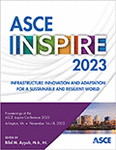Graph Theory-Based Characterization of Disaster-Induced Flow Redistributions in Civil Infrastructure Systems
Publication: ASCE Inspire 2023
ABSTRACT
In this pressing time of climate change, civil infrastructure systems are increasingly challenged by more frequent and intensified natural disasters. Natural disasters cause damages to infrastructure systems, lead to system dysfunctionality and system topology change, and force system flows to redistribute. Without characterization and control, such flow redistribution can trigger the “domino effect,” causing the redistribution to cascade at the system level. To support the control of such cascading, this paper aims to characterize the flow redistribution, forced by disaster-induced infrastructure topology change, for civil infrastructure systems. The proposed characterization method includes two steps: (1) quantifying flow redistributions at the network link level, and (2) assessing the topological properties of each network link using graph theory. The quantified flow redistributions and assessed topological properties are linked to discover and characterize the behaviors and patterns of flow redistribution. The implementation of the proposed method in transportation infrastructure systems showed that (1) the flow redistribution behaviors and patterns varies across links with different topological properties, and (2) damaged links that are well-connected are more likely to have greater impacts on their neighboring links.
Get full access to this article
View all available purchase options and get full access to this chapter.
REFERENCES
ASCE. (2021). 2021 Infrastructure Report Card. ASCE, Reston, VA.
Axhausen, K., Horni, A., and Nagel, K. (2016). The multi-agent transport simulation MATSim (p. 618). Ubiquity Press.
Bak, P., Tang, C., and Wiesenfeld, K. (1987). “Self-organized criticality: An explanation of the 1/f noise.” Physical review letters, 59(4), 381.
Borowska-Stefańska, M., Domagalski, A., and Wiśniewski, S. (2018). “Changes concerning commute traffic distribution on a road network following the occurrence of a natural disaster–The example of a flood in the Mazovian Voivodeship (Eastern Poland).” Transportation Research Part D: Transport and Environment, 65, 116–137.
Cassottana, B., Biswas, P. P., Balakrishnan, S., Ng, B., Mashima, D., and Sansavini, G. (2022). “Predicting Resilience of Interdependent Urban Infrastructure Systems.” IEEE Access, 10, 116432–116442.
Diestel, R. (2005). Graph Theory (3rd ed.). Berlin. New York: Springer-Verlag, ISBN 978-3-540-26183-4.
Goldbeck, N., Angeloudis, P., and Ochieng, W. Y. (2019). “Resilience assessment for interdependent urban infrastructure systems using dynamic network flow models.” Reliability Engineering & System Safety, 188, 62–79.
Hagberg, A., Swart, P., and S Chult, D. (2008). Exploring network structure, dynamics, and function using NetworkX. Los Alamos National Lab.(LANL), Los Alamos, NM (United States).
Motter, A. E., and Lai, Y. C. (2002). “Cascade-based attacks on complex networks.” Physical Review E, 66(6), 065102.
NASEM (National Academies of Sciences, Engineering, and Medicine). (2019). Environmental Engineering for the 21st Century: Addressing Grand Challenges. NASEM, Washington, DC: The National Academies Press. https://doi.org/10.17226/25121.
NOAA and NCEI (National Oceanic and Atmospheric Administration and National Centers for Environmental Information). (2023). U.S. Billion-Dollar Weather and Climate Disasters, <https://www.ncei.noaa.gov/access/billions/>https://doi.org/10.25921/stkw-7w73.
Pei, J., Liu, Y., Wang, W., and Gong, J. (2021). “Cascading failures in multiplex network under flow redistribution.” Physica A: Statistical Mechanics and its Applications, 583, 126340.
Pyatkova, K., Chen, A. S., Djordjević, S., Butler, D., Vojinović, Z., Abebe, Y. A., and Hammond, M. (2019). “Flood impacts on road transportation using microscopic traffic modelling techniques.” In Simulating Urban Traffic Scenarios: 3rd SUMO Conference 2015 Berlin, Germany (pp. 115–126). Springer International Publishing.
Rosvall, M., Trusina, A., Minnhagen, P., and Sneppen, K. (2005). “Networks and cities: An information perspective.” Physical Review Letters, 94(2), 028701.
Sabidussi, G. (1966). “The centrality index of a graph.” Psychometrika. 31 (4): 581–603. https://doi:10.1007/bf02289527.
Schaub, M. T., Lehmann, J., Yaliraki, S. N., and Barahona, M. (2014). “Structure of complex networks: Quantifying edge-to-edge relations by failure-induced flow redistribution.” Network Science, 2(1), 66–89.
Shen, Y., Ren, G., Zhang, N., Song, G., Wang, Q., and Ran, B. (2020). “Effects of mutual traffic redistribution on robustness of interdependent networks to cascading failures under fluctuant load.” Physica A: Statistical Mechanics and Its Applications, 560, 125138.
Wang, W. X., and Chen, G. (2008). “Universal robustness characteristic of weighted networks against cascading failure.” Physical Review E, 77(2), 026101.
Xu, Y., Shaw, S. L., Zhao, Z., Yin, L., Lu, F., Chen, J., Fang, Z., and Li, Q. (2016). “Another tale of two cities: Understanding human activity space using actively tracked cellphone location data.” Annals of the American Association of Geographers, 106(2), 489–502.
Yağan, O. (2015). “Robustness of power systems under a democratic-fiber-bundle-like model.” Physical Review E, 91(6), 062811.
Zaki, M. J., and Meira, W. (2014). Data mining and analysis: fundamental concepts and algorithms. Cambridge University Press.
Information & Authors
Information
Published In
History
Published online: Nov 14, 2023
ASCE Technical Topics:
Authors
Metrics & Citations
Metrics
Citations
Download citation
If you have the appropriate software installed, you can download article citation data to the citation manager of your choice. Simply select your manager software from the list below and click Download.
